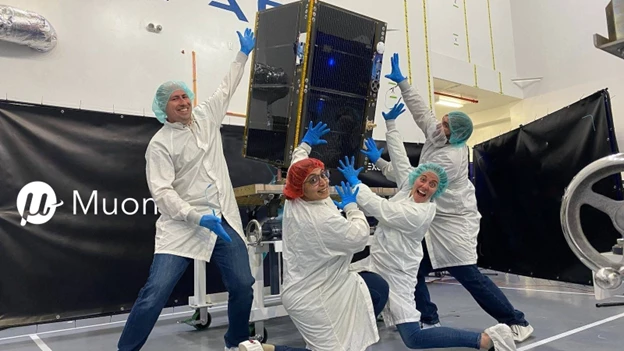Announcements, Azure Compute, Azure Orbital Ground Station, Compute, Networking, Storage, Thought leadership
Accelerating the pace of innovation with Azure Space and our partners
Posted on
6 min read
Azure Space innovating into the future
Today, I’m excited to share some news spanning the full spectrum of space industry use cases, including:
- Real-world examples of how Azure Orbital Ground Station is enabling both space agencies and start-ups with new ways to operate satellites in orbit.
- A new addition to the Azure Space family, the Planetary Computer (and the petabytes of data within its catalog). Together, with new partnerships with Esri and Synthetaic, we are on a journey to empower our customers through rapid new insights from earth observation data.
When Microsoft announced Azure Space in 2020, we saw a chance to innovate new solutions that meet modern demands and create opportunities for the future. So, we applied our proven partner-first approach to rapidly reimagine traditional space solutions, introduce new software-based tools, and minimize cost barriers holding back the space ecosystem.
This partner-first approach has allowed us to rapidly go from vision to solutions. In October 2020, we shared early outcomes that collectively brought Azure together with a global effort of ground stations, provided resilient connectivity to the hyperscale cloud, and launch a transformational effort to virtualize satellite communications.

Azure customers
Since then, both established satellite operators and exciting new start-ups have redefined the on-orbit possibilities. Now, start-ups, government agencies, and enterprises are experimenting with new form factor satellites, relying upon Earth observation data to derive actionable insights, and identifying ways to maintain constant connectivity in unpredictable global environments.
Together with our partners, we are rapidly innovating to provide every space operator with the solutions to solve persistent challenges in new ways and capture new opportunities in the rapidly expanding space sector.
Azure Orbital Ground Station supports our customers on and off the planet
Cloud computing is the foundation that underpins one of the biggest revolutions in the space industry, ground stations as a service. Those ground stations, in turn, have drastically lowered one of the most expensive barriers to entering space. One year after Azure Orbital Ground Station became generally available, customers including NASA and Muon Space are using it to support their operations.
Use KSAT and Azure Orbital Ground Station to improve delivery of NASA’s earth science data products
Teams from NASA (Langley Research Center and Goddard Space Flight Center), the global space company KSAT, and Microsoft have completed a technology demonstration. The demo focused on data acquisition, processing, and distribution of near real-time Earth Science data products in the cloud.
The teams successfully validated space connectivity across KSAT and Microsoft Azure Orbital Ground Station sites with four public satellites owned by both NASA and the National Oceanic and Atmospheric Administration (NOAA): Terra, Aqua, Suomi National Polar-orbiting Partnership, and JPSS-1/NOAA-20.
The demonstration was a showcase for Azure, which provided real-time cross-region data delivery from Microsoft and KSAT sites to NASA’s virtual network in Azure. With satellite data in the cloud, NASA Azure compute and storage services to take data from raw form to higher processing levels (see sample final product in Image 1) improving latency from an average of 3-6 hours to under 25 minutes for some data products.
Integration of capabilities across Microsoft and partner KSAT allowed NASA to expand its coverage and connectivity, benefiting from ground station access through a single application programming interface (API), direct backhaul into Azure, cross-region delivery, and a unified data format experience.

Muon Space achieves liftoff and successful operations with MuSat-1 and Azure Orbital Ground Station
Muon Space selected Microsoft to support its first-ever launch in June 2023, leveraging Azure Orbital Ground Station as the sole ground station provider for their MuSat-1 mission. After MuSat-1 was deployed from the SpaceX Transporter 10, Muon Space achieved contact via Azure Orbital Ground Station within six minutes.1 From the launch and early operation (LEOP) stage to continuous on-orbit operations, Microsoft ground stations around the world are used to successfully communicate with MuSat-1. Azure Orbital Ground Station is a completely cloud-based solution. Therefore, hardware deployment was not needed, enabling Muon Space to take advantage of an innovative virtual radio frequency (RF) solution with a custom modem.
“Since we’re building constellations of multiband remote sensing spacecraft with unique revisit, resolution, and data latency capabilities, our ground station partner was a critical choice. Muon selected Azure Orbital Ground Station as we launch our constellation due to its current capabilities and product roadmap. Collaborating with Microsoft to handle ground allows us to focus on the core mission of gathering climate intelligence and serving it to our customers.”
Jim Martz, Vice President, Engineering at Muon.

Expanding capabilities to derive rapid insights from massive amounts of space data
Today, we are applying that same approach to revolutionize geospatial data, as we welcome Planetary Computer to the Azure Space family. Planetary Computer is a robust geospatial data platform. It combines a multi-petabyte catalog of global multi-source data with intuitive APIs, a flexible scientific environment that allows users to answer global questions about that data, and applications that put those answers in the hands of many stakeholders. It is used by researchers, scientists, students, and organizations across the globe with millions of API calls every month.
With Planetary Computer now part of the Azure Space family, we are beginning to work with partners in new ways. Today, we are building upon the existing catalog to drive a path to new capabilities and partnerships that will empower users with one of the largest Earth observation data sets at their fingertips—petabytes worth of possibilities for understanding our planet. In keeping with our partner-first approach, Esri and Synthetaic will provide essential capabilities to our platform and ecosystem. By combining the power of data analysis in Synthetaic’s RAIC, with the data visualization of Esri’s ArcGIS, customers will be able to glean insights from space data at previously unattainable speed and scale.


Planetary Computer is grounded in our commitment to not only better understand our world but to leverage the insights we gain to achieve our commitments to being a carbon-negative, water-positive, and zero-waste company by 2030. A quick look at Chesapeake Conservancy, a nonprofit organization based in Annapolis, Maryland, illustrates the possibilities that Planetary Computer can unlock for any organization to achieve its sustainability goals.
Chesapeake Conservancy is leading a regional effort to protect 30 percent of the Chesapeake Bay watershed by 2030 using a precision conservation approach that optimizes resources and protects land with the greatest value for water quality, outdoor recreation, wildlife habitat, and local economies.
“Collaborating with Microsoft Azure, we developed an AI system that maps ground-mounted solar arrays using up-to-date satellite data enabling us to regularly track one of the most rapid drivers of land use change in the watershed,” says Joel Dunn, CEO, Chesapeake Conservancy. “Going forward, we must contextualize these insights within a complete, up-to-date picture of land use. We’re excited to work with Microsoft and their partners to produce our 1-meter land use data more frequently and accurately keeping an active pulse on the entire Chesapeake Bay watershed.”

Using tools from our partners to harness the power of Microsoft Planetary Computer, customers such as Chesapeake Conservancy can use artificial intelligence and groundbreaking data to accelerate progress in conserving landscapes vital to the Chesapeake Bay’s health and its cultural heritage while equitably connecting people to the Chesapeake, as seen in the video here.
The space industry has made incredible progress since the dawn of the space age in the 1950s. That progress, however, has been slow, hard, and expensive. It has required expensive and sustained investments by governments, followed by the creation of bespoke, rigid, and complex-to-integrate satellite constellations and ground infrastructure.
What’s next for Azure Space
Building on the Microsoft Planetary Computer to develop a new Azure Space Data solution will create an end-to-end space fabric, providing ubiquitous connectivity, resiliency, and global insights at scale, in real-time. We are excited to build this platform and open it to the many companies, large and small, who are shaping the future of space and look forward to collaborating with those writing the next chapter in humanity’s journey beyond Earth.
We invite partners and enterprises interested in learning more about Azure Space to do the following:
- Learn more about Azure Space
- Sign up for news and updates on how Space data can advance your organization and missions, or complete this form to get in touch with the Azure Space team.
- Save the date—join us for the Planetary Computer webinar in December.
References